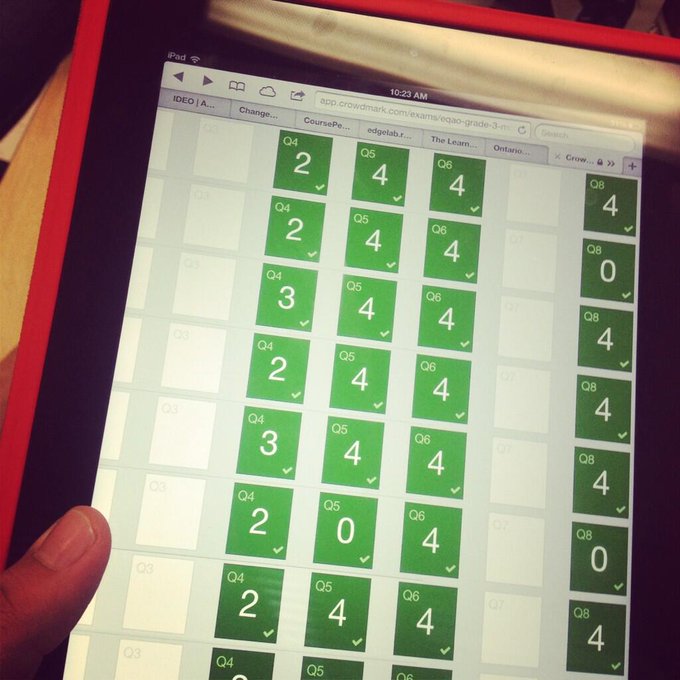A teacher’s inside look at the Golf Road Junior Public School pilot
The Education Quality and Accountability Office (EQAO is a Crown agency of the government of Ontario that administers province-wide standardized tests to all public school students in grades 3, 6, 9 and 10. Crowdmark was recently used by groups of teachers at Golf Road Junior Public School to carry out moderated marking of grade 3 and grade 6 mock EQAO exams. The experiment was a tremendous success.
I’ve had the privilege to be a member of MaRS Discovery District’s (MaRS) Teacher Advisory Panel—a group of teachers that offers feedback to entrepreneurial teams working in education about their products and/or services. Through the panel, I met James Colliander, the founder of Crowdmark—a web-based assessment system.
I was immediately impressed with how easy it is to access Crowdmark and the speed with which it allows teachers to grade an assessment compared to conventional red pen and paper practices. I began thinking about how this resource could be used to support the teachers I work with and the students we assess if Crowdmark were our primary assessment tool.
After some discussions, we created a pilot study for Crowdmark at Golf Road Junior Public School as part of our annual EQAO Mock Assessment — a larger than usual school-wide, scaled assessment of our grade 3 and grade 6 students.
Typically, we offer students general feedback on their completed tests based on the leveled examplars provided by EQAO, but teachers rarely work through each individual mock assessment due to timing and feasibility constraints in handling so many test hardcopies.
I thought of Crowdmark’s ability to toggle through separate tests (specific to student and individual questions), offer authentic teacher feedback through its comment feature and its capabilities for staff collaboration and moderated marking. Crowdmark fit our needs.
With support from our administration team and grade 3 and grade 6 teachers, James and I developed a pilot timeline within two weeks and the separate mock-test documents with EQAO-style questions. The Crowdmark team provided great support and, after customizing the mock tests by selecting specific EQAO questions and generating separate student rosters for each grade, we were up and running!
As a school, we set aside a Monday morning for students to write their tests and the following Tuesday morning for teachers to assess these tests. Students completed the tests in hard copy. They were then scanned and uploaded to Crowdmark.

On Tuesday morning, teachers were greeted with an email inviting them as markers to their specific grade test. Our grade 3 and grade 6 teachers worked in the same space, on separate devices—I monitored teacher progress for each grade 3 and grade 6 assessment using my iPad—assessing either the same student’s test simultaneously or by working on specific questions through the entire student roster using strategies developed by the separate teams of teachers.

As the student names were disconnected from the tests, teachers worked through their answers without bias. This function allows the teacher to provide feedback on only the content without any expectations of how a certain student “should do” on the test.
As teachers worked, they said it was easy to switch between questions and students – something that is much more challenging when working with red pen and paper. Teachers were also able to assign each student a grade for each piece completed while providing rich feedback through the comment feature that students could later see. Teachers flagged particular tests for colleagues to review and easily discussed strategies for collaborative assessment and specific grades assigned. Our grade 3 and grade 6 teams completed their assessments in half the time traditional marking would take, something that made them ecstatic about Crowdmark.
After our moderated marking session ended, the Crowdmark team provided feedback to our grade 6 students via TDSB-issued email accounts we had provided. This fantastic feature meant that students, parents and guardians could easily access the assessed results.
When asked about what it was like to use Crowdmark, teachers commented on its efficiency and speed, and how easy it was to move across tests and through the interactive interface. This simplicity allowed them to focus on the assessment one question at a time rather than shuffling, turning and adjusting papers. They also liked the efficient and collaborative moderated marking scenarios, and the collaborative power to engage students, parents and guardians in the assessment process.
Overall, our teachers were overwhelmingly positive about using Crowdmark.
As Golf Road Junior Public School’s ICT lead teacher and researcher of virtual world teaching and learning experiences, I’m eager to work with Crowdmark again on different assessment scenarios. For small-scale to large-scale assessments, I believe that this web-based, robust and extremely easy-to-use system has a place in my practice and that of my colleagues. Crowdmark definitely does allow me to grade better.
Joseph Romano (OCT, MEd, BEd, BFA) is the ICT Lead Teacher and Junior Division Position of Responsibility (POR) at Golf Road Junior Public School in the Toronto District School Board, and is a researcher of Virtual World Pedagogy. Joseph also curates content and blogs at Classpace and contributes as an Educational Technology Advisor at MaRS Discovery District.
